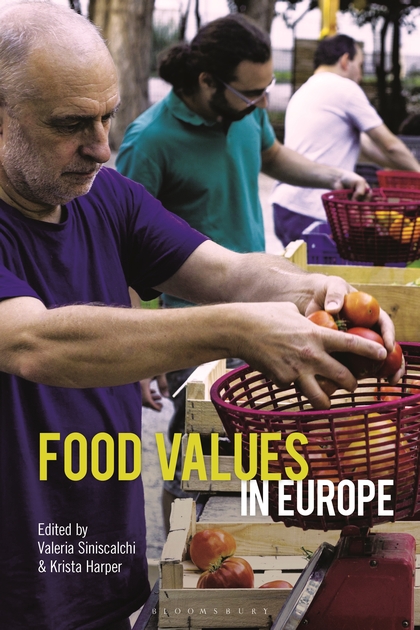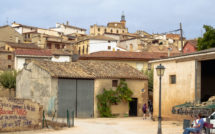

The rich case studies in this volume explore distinctively European contexts of activism to challenge the dominance of industrial food systems. What the editors refer to as “food values” articulate the most basic of human and social needs with issues of identity and belonging, the dignity of labor, and expectations of morality, reciprocity, and care. Emergent subjectivities are shaped in the context of ongoing collaborations around food in Portugal, Austria, the Czech Republic, Spain, Italy, Greece, Latvia, Moldova, Denmark, France, and England. The contributors are attentive to illustrate the culturally meaningful local worlds in which networks take shape to transform the social relations of production, distribution, processing and consumption. The volume includes examples of several kinds of movements and projects, from urban community gardens, producer-consumer solidarity, food communities in diaspora, and subsistence self-provisioning, to the promotion of organics, Fair Trade and Food Sovereignty, and protest against aspects of Europe’s infamous Common Agricultural Policy.
How food production and provisioning integrate key dimensions of social, economic, and moral life is too rarely foregrounded in critiques of late capitalism. This collection lets us glimpse crucial articulations of scale, where activities to reproduce society at the household, family, and community levels engage the broader spaces of the market and civic life. Ethnographic approaches demonstrate that the significance of food extends far beyond utilitarian values. For Europeanists, vivid evidence of the symbolic and cultural weight attached to social interactions around subsistence agriculture, food preparation, hospitality, and commensality in our fieldsites has long inspired lively themes of scholarship that inform the studies in this book. Food Values in Europe is worth reading and discussing because it brings this exceptionally well-developed anthropology and sociology of European food and agriculture into conversation with the critique of globalized food systems and the commodity fetishisms they entail.
The case studies presented here include inspiring examples of how local solidarities support alternative food chains and socio-economic spaces. In Thessaloniki, Theodoros Rakopoulos found an “anti-middleman” food cooperative that enhanced the economic resilience of many members in the context of the Greek economic crisis, creating opportunities for paid work. In Catalonia, according to Patricia Homs and Suzana Narotzky, organic food cooperatives have organized around attempts to de-alienate the labor of food production, and make the role of the small farmer less subject to precarity by creating meaningful social connections between producers and consumers. Such solidarities are not uncomplicated, however, nor can the alternative spaces they generate function in idyllic isolation from the spaces of capitalism. The “dissident space” of the Catalonian co-op was both dependent upon and limited by its embeddedness in the margins of the capitalist system (142), while the Greek co-op was subject to labor disputes. Comparatively, Valeria Siniscalchi notes that notwithstanding the exceptional success of producer-consumer alliances around vegetable baskets in Southern France, “the market can enter the system through the back door” (126). In a Lisbon urban garden, Krista Harper and Ana Isabel Afonso recall how class tensions emerged around the commodification of labor in a great debacle over rototilling. In Cary Speck’s research in Prague, “productive leisure” in community gardens was often tied into the production of social distinction, while only certain gardens were deliberately organized with activist goals in mind. In an Austrian example, Elisabeth Kosnick recognizes that efforts of household self-provisioning have tended to be a lifestyle of choice, predicated upon pre-existing material security.
Debates about how we get our food—and what kind of food we should be trying to get—ultimately lead back to understandings of structural inequality, power and resistance. In less developed parts of Spain and Italy, contestation over the impacts of policies liberalizing the dairy sector dramatize the issues at hand. Bibiana Martínez Álvarez explains that Galician herders attending the trattorada protests against changes to the Common Agricultural Policy understand the “just price of milk” as one that permits rural households to survive. Similarly, Pitzalis and Zerilli chronicle the efforts of central Sardinians participating in activities of the movimento pastori sardi, who redefine their work as shepherds to encompass ecological services and the guardianship of trustworthy food quality. Another chapter by Delphine Thivet provides a longitudinal account of how European peasants mobilized a critical response to agricultural policies, ultimately developing into the European movement for Food Sovereignty. In all of these cases, the protagonists of small agricultural enterprises in the European countryside are active agents in reshaping the moral economy of food.
Richard Wilk characterizes recent food movement activism as coalescing around human rights and social justice, health and food safety, and finally, sustainability and environmental impacts. In his insightful comments concluding this collection, he reflects on the utopian leitmotifs in these projects to resist the commodification of food. Cautioning against a simplistic perception of triumphant grassroots resistance against the food regimes of global capitalism, he emphasizes how deeply our formal and informal economic activities are intertwined, and how ambivalent, heterogeneous and contested are the values we hold surrounding food and its consumption. This is directly demonstrated by the inclusion in the volume of case studies about food projects that are not organized around the mandates of global food activism. Dana Conzo discusses how the shared meals of Caribbean migrants in England mobilized minority food traditions in order to navigate racism and marginalization in diaspora. Similarly, Johan Fischer talks about what it means to be halal in Denmark. Jennifer Cash offers an account of how poverty calculations in Moldova have misunderstood the cultural role of food. The plurality of foodways demands that cultural critique and reflexivity temper food movements, lest new forms of exclusion be embedded in the alternatives we work to create.
A book like this has never been more resonant and provocative than now, in the midst of a pandemic that has surely shaken confidence in how we coordinate our food supply. As lowly meat packers, fruit pickers, and grocery store clerks became essential workers on “the frontlines” of a growing global crisis, the ethical dimensions of household provisioning have shifted to throw off the hegemonic invisibility of these actors’ place in the social order, revealing their precarity, vulnerability, and ultimately, their importance. COVID-19 has exposed the faultlines of neoliberalism everywhere in our food systems, perhaps as never before.
It shines a harsh light on how food nationalisms are embodied, as the significance of borders is renewed in ways that privileged consumers had too easily forgotten. Suddenly the stakes involved when migrant farm laborers seek to move between countries are a matter of public concern. Governments compromise between biosecurity and the need for skilled agricultural labor, for when too many crops go without harvest, scarcity follows. The very people who guarantee national food security may be banished to “bare life” (Agamben 1995) in crowded work zones and barracks that afford little protection from the spread of infection. If the biopolitics of agriculture has long been a secret shame of the world’s most developed and prosperous nations, the very taste of that shame is now public.
While trucks full of goods might still roll through the checkpoints to ensure supplies for all who can afford them, our distribution networks are no longer something we can take for granted, especially when the simple act of going to the store constitutes uncertain risk. In North America, some of us grew familiar with—and grateful for—grocery delivery services like Amazon, Instacart, or SPUD.ca, while others eagerly planted gardens or signed into CSAs. After the challenges of household provisioning in the first months of the crisis, I felt an unexpected kinship with Latvians when reading Guntra Aistara’s memorable chapter on how people creatively mobilized informal networks to obtain access to restricted supplies of bananas under socialism. That such experiences might render today’s Latvians less inclined to cultivate the ethical orientations of neoliberal morality embedded in Fair Trade models, for example, suggests that parallels could result elsewhere, as crisis subjectivities coalesce.
The pandemic has shaped heterogeneous impacts upon the spaces of alternative agriculture and their aspirational socialities—and here lies terrain for the study of emergent “food values” that has yet to be explored. The comparative work begun in this exquisitely useful volume challenges us all to consider how the social movements around food, and other miscellaneous food projects, are responding to our rapidly changing socio-economic contexts, to engender resilience and open possibilities for the future.
Tracey Heatherington is Associate Professor of Anthropology at the University of British Columbia, Canada. Her research has focused on culture and environment in Italy and Europe. Her current work studies the emergence of diverse cultural projects for seed banking and seed saving, particularly in the context of European and global initiatives for sustainable agriculture in the Anthropocene.
Food Values in Europe
Edited by Valeria Siniscalchi and Krista Harper
Publisher: Bloomsbury Academic
Hardcover / 245 pages / 2019
ISBN 978-1-3500-8477-3
Published on November 10, 2020.




